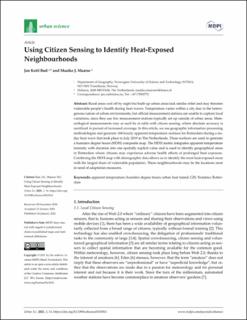| dc.contributor.author | Rød, Jan Ketil | |
| dc.contributor.author | Maarse, Maaike J. | |
| dc.date.accessioned | 2021-02-02T10:08:21Z | |
| dc.date.available | 2021-02-02T10:08:21Z | |
| dc.date.created | 2021-01-25T17:59:35Z | |
| dc.date.issued | 2021 | |
| dc.identifier.citation | Urban Science. 2021, 5 (1), . | en_US |
| dc.identifier.issn | 2413-8851 | |
| dc.identifier.uri | https://hdl.handle.net/11250/2725744 | |
| dc.description.abstract | Rural areas cool off by night but built-up urban areas lack similar relief and may threaten vulnerable people’s health during heat waves. Temperature varies within a city due to the heterogenous nature of urban environments, but official measurement stations are unable to capture local variations, since they use few measurement stations typically set up outside of urban areas. Meteorological measurements may as such be at odds with citizen sensing, where absolute accuracy is sacrificed in pursuit of increased coverage. In this article, we use geographic information processing methodologies and generate 144 hourly apparent temperature surfaces for Rotterdam during a sixday heat wave that took place in July 2019 in The Netherlands. These surfaces are used to generate a humidex degree hours (HDH) composite map. The HDH metric integrates apparent temperature intensity with duration into one spatially explicit value and is used to identify geographical areas in Rotterdam where citizens may experience adverse health effects of prolonged heat exposure. Combining the HDH map with demographic data allows us to identify the most heat-exposed areas with the largest share of vulnerable population. These neighbourhoods may be the locations most in need of adaptation measures. | en_US |
| dc.language.iso | eng | en_US |
| dc.publisher | MDPI | en_US |
| dc.rights | Navngivelse 4.0 Internasjonal | * |
| dc.rights.uri | http://creativecommons.org/licenses/by/4.0/deed.no | * |
| dc.title | Using citizen sensing to identify heat exposed neighbourhoods | en_US |
| dc.type | Peer reviewed | en_US |
| dc.type | Journal article | en_US |
| dc.description.version | publishedVersion | en_US |
| dc.source.volume | 5 | en_US |
| dc.source.journal | Urban Science | en_US |
| dc.source.issue | 1 | en_US |
| dc.identifier.doi | https://doi.org/10.3390/urbansci5010014 | |
| dc.identifier.cristin | 1878937 | |
| dc.relation.project | Norges forskningsråd: 274192 | en_US |
| dc.relation.project | EU/690462 | en_US |
| dc.description.localcode | This is an open access article distributed under the Creative Commons Attribution License which permits unrestricted use, distribution, and reproduction in any medium, provided the original work is properly cited | en_US |
| cristin.ispublished | true | |
| cristin.fulltext | original | |
| cristin.qualitycode | 1 | |

